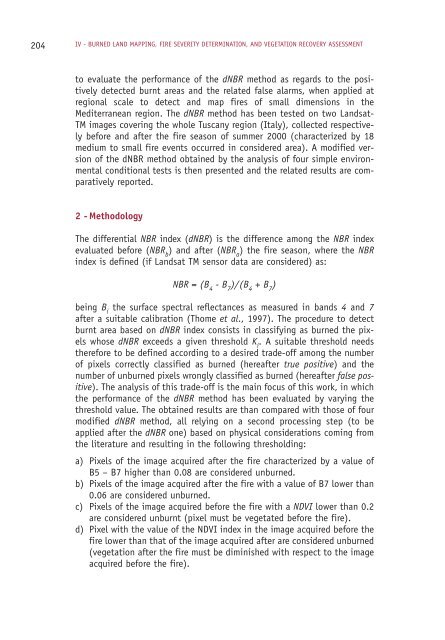7th Workshop on Forest Fire Management - EARSeL, European ...
7th Workshop on Forest Fire Management - EARSeL, European ...
7th Workshop on Forest Fire Management - EARSeL, European ...
You also want an ePaper? Increase the reach of your titles
YUMPU automatically turns print PDFs into web optimized ePapers that Google loves.
204<br />
IV - BURNED LAND MAPPING, FIRE SEVERITY DETERMINATION, AND VEGETATION RECOVERY ASSESSMENT<br />
to evaluate the performance of the dNBR method as regards to the positively<br />
detected burnt areas and the related false alarms, when applied at<br />
regi<strong>on</strong>al scale to detect and map fires of small dimensi<strong>on</strong>s in the<br />
Mediterranean regi<strong>on</strong>. The dNBR method has been tested <strong>on</strong> two Landsat-<br />
TM images covering the whole Tuscany regi<strong>on</strong> (Italy), collected respectively<br />
before and after the fire seas<strong>on</strong> of summer 2000 (characterized by 18<br />
medium to small fire events occurred in c<strong>on</strong>sidered area). A modified versi<strong>on</strong><br />
of the dNBR method obtained by the analysis of four simple envir<strong>on</strong>mental<br />
c<strong>on</strong>diti<strong>on</strong>al tests is then presented and the related results are comparatively<br />
reported.<br />
2 - Methodology<br />
The differential NBR index (dNBR) is the difference am<strong>on</strong>g the NBR index<br />
evaluated before (NBR b ) and after (NBR a ) the fire seas<strong>on</strong>, where the NBR<br />
index is defined (if Landsat TM sensor data are c<strong>on</strong>sidered) as:<br />
NBR = (B 4 - B 7 )/(B 4 + B 7 )<br />
being B i the surface spectral reflectances as measured in bands 4 and 7<br />
after a suitable calibrati<strong>on</strong> (Thome et al., 1997). The procedure to detect<br />
burnt area based <strong>on</strong> dNBR index c<strong>on</strong>sists in classifying as burned the pixels<br />
whose dNBR exceeds a given threshold K i . A suitable threshold needs<br />
therefore to be defined according to a desired trade-off am<strong>on</strong>g the number<br />
of pixels correctly classified as burned (hereafter true positive) and the<br />
number of unburned pixels wr<strong>on</strong>gly classified as burned (hereafter false positive).<br />
The analysis of this trade-off is the main focus of this work, in which<br />
the performance of the dNBR method has been evaluated by varying the<br />
threshold value. The obtained results are than compared with those of four<br />
modified dNBR method, all relying <strong>on</strong> a sec<strong>on</strong>d processing step (to be<br />
applied after the dNBR <strong>on</strong>e) based <strong>on</strong> physical c<strong>on</strong>siderati<strong>on</strong>s coming from<br />
the literature and resulting in the following thresholding:<br />
a) Pixels of the image acquired after the fire characterized by a value of<br />
B5 – B7 higher than 0.08 are c<strong>on</strong>sidered unburned.<br />
b) Pixels of the image acquired after the fire with a value of B7 lower than<br />
0.06 are c<strong>on</strong>sidered unburned.<br />
c) Pixels of the image acquired before the fire with a NDVI lower than 0.2<br />
are c<strong>on</strong>sidered unburnt (pixel must be vegetated before the fire).<br />
d) Pixel with the value of the NDVI index in the image acquired before the<br />
fire lower than that of the image acquired after are c<strong>on</strong>sidered unburned<br />
(vegetati<strong>on</strong> after the fire must be diminished with respect to the image<br />
acquired before the fire).
















